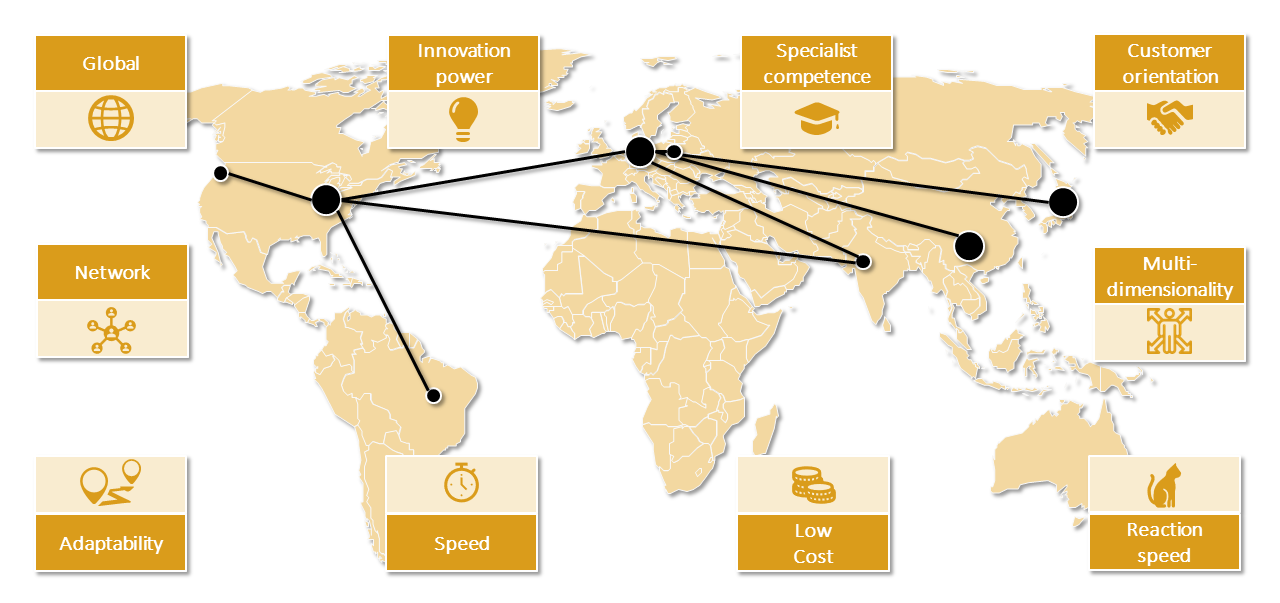Flexibility and efficiency
Globalisation, the increasing speed and unpredictability of change, the growing complexity of one’s own product and service offering and high cost pressure place significant demands on an organisational structure for product development. Therefore, your organisational structure must not only deliver an optimal support strategy and the requisite processes as before, but be also perfectly embedded in the company organisation and provide orientation for your employees. Going forward, it must also anticipate new requirements and framework conditions even faster and with greater flexibility while keeping costs under control. This can only be achieved with a perfect balance of lean, customer-oriented organisational units, which act with entrepreneurial spirit and which are supported by synergistic cross-sectional areas.
Increasing the entrepreneurial surface
To best deal with the increasing dynamics of markets and customer demands, you need a lot of “speedboats” that have the following characteristics:
- They are led by a visionary “entrepreneur within the enterprise” with real “profit responsibility” and an agile leadership style.
- They have all the decentralised decision-making powers they need to react quickly.
- They know their markets and customers, but also their core competences, in detail.
- They have interdisciplinary procedural responsibility for the product development process.
- They have all the personnel competencies they need to manage the product development process.
- They remain lean, so as not to build up redundant resources.
Depending on the business, entrepreneurial- and market-, as well as customer-oriented organisational units are formed according to different structuring principles:
- By market segments
- By customers or customer groups
- By regions
- By products
Flexibility
By establishing as many responsible “entrepreneurs within the enterprise” as possible, they primarily increase the operational flexibility and speed of your company. They remain close to the market and customers, while also being able to experience (or anticipate) changing requirements immediately. Due to their business responsibility, they enjoy a high level of motivation to adapt their offer as quickly as possible. On the other hand, they have all the decision-making powers and do not have to go through lengthy decision-making processes. Given that they have all personnel competencies for the complete product development process “on board”, they can initiate and implement adjustments to their product portfolio or to the goals and contents of their product development projects immediately.
This works especially well with agile teams. There, the role of the “smallest entrepreneur in the company” is exercised by the product owner. He will coordinate with stakeholders, but he decides himself on the contents of the product backlog. His interdisciplinary team possesses all the competencies for implementing the product requirements. Sprint reviews enable rapid adaptation to customer feedback. But classic product- or customer line organisations also follow this principle when the essential roles for managing product development are brought together in a lean unit: Product Manager or Key Account Manager, Project Leader, Systems Engineer, Project Buyer, Production Engineer, Quality Manager and Controller.
So, of the various characteristics that your product creation organisation should have, the companies within the company stand, above all, for:
- Customer orientation
- Speed
- Reactivity
- Adaptability
- Innovation
The larger your entrepreneurial surface becomes, i.e. the more entrepreneurs you have in the company, the more powerful your overall organisation will be. You can, of course, break down entrepreneurial responsibility in hierarchical terms according to the above-mentioned characteristics, starting with the business unit. The smallest entrepreneurial unit, a so-called “temporary company” so to speak, is the classic or agile project team.
Synergetic cross-sectional areas
You place synergy-generating, cross-sectional areas alongside these “entrepreneurs”. Their remit requires them to:
- Provide the necessary technical expertise and capacity.
- Contribute the necessary technologies for the realisation of product and service functions.
- Develop technical platforms and modular building blocks.
- Work with corporate organisational units.
- Ensure a global, cross-functional exchange of expertise.
Depending on the complexity of your service and product offering, the cross-sectional areas are formed according to different structuring principles, e.g.:
- According to specialist domains (e.g. mechanics, electronics, software)
- According to value streams (e.g. pre-development, module development, series development, series support)
- By technologies
- By modules
Their cross-sectional areas primarily stand for:
- A global alignment
- Innovation
- Professional competence
- Cost efficiency
- Speed
- Network
The benefit to you
- You create responsive organisational units that create competitive advantage in the VUCA world.
- You ensure a high level of customer orientation.
- You consistently realise cross-market and cross-customer sources of synergy potential.
- You are aware of the sources of potential friction stemming from diverging goals and use them to achieve the best solution from a holistic company perspective.



